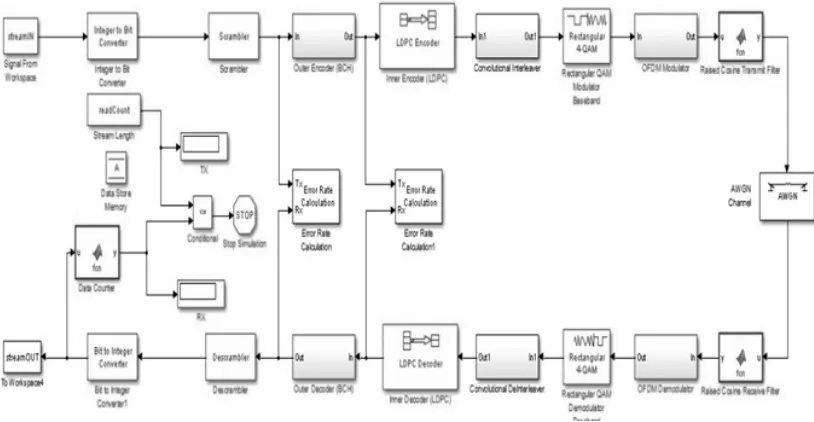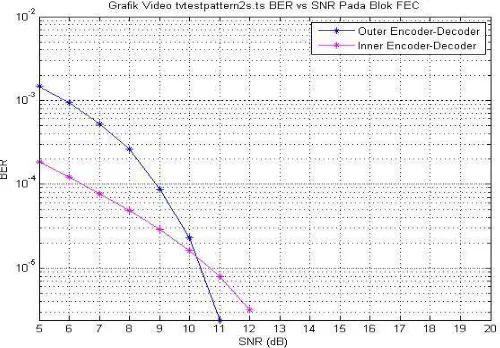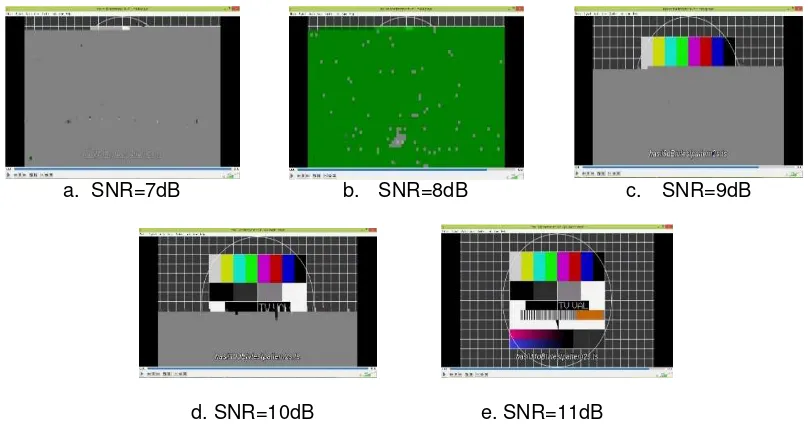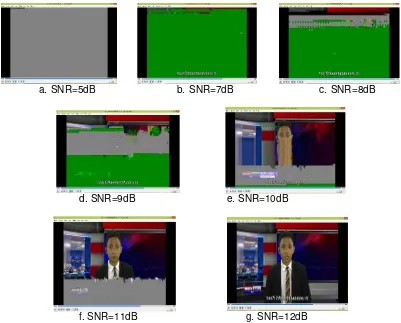DOI: 10.12928/TELKOMNIKA.v14i3.3830 873
The Design and Performance Analysis of
Digital Terrestrial Multimedia Broadcasting System
Emy Haryatmi*, Tubagus Maulana Kusuma, Busono Soerowirdjo, Purnawarman Musa Universitas Gunadarma, Jl. Margonda Raya No. 100, Depok 16424, Jawa Barat, (021) 78881112
*Corresponding author: e-mail: emy_h@staff.gunadarma.ac.id
Abstract
Various standards have been developed for digital television broadcasting systems in the world. Consequently, Digital Terrestrial Multimedia Broadcasting (DTMB) is one of the digital television standards that is currently used by China and Hong Kong. DTMB standard consists of various configuration parameters that can be chosen for different applications. Therefore, DTMB system was designed in this research based on standard GB20600-2006 and was validated using computer program named Simulink. The parameters used for the design were FEC with code rate of 0.4, 4QAM mapping, interleaving mode 1 and single carrier mode. Those parameters were chosen based on low implementation complexity thus generates good results. The input for DTMB system was MPEG-2 audio and video Transport Stream (TS) structure. DTMB system consists of two important things such as the existence of FEC and TDS-OFDM. DTMB system uses concatenated codes in FEC. They are BCH as the outer codec and LDPC as the inner codec. DTMB system uses TDS-OFDM because it provides better picture quality when the receiver is in motion. Simulation results shows that DTMB is able to receive video with identical quality compared to the original video when the value of SNR=11 dB for static video and SNR=12 dB for dynamic video. It is shown that the number of bit errors decrease as the value of SNR increase when the process passes from LDPC to BCH.
Keywords: DTMB, digital TV, broadcasting, simulation, Simulink
Copyright © 2016 Universitas Ahmad Dahlan. All rights reserved.
1. Introduction
Digital television has become one of the interesting topics in broadcasting area in recent years. Digital television broadcasting system is able to deliver better quality of picture and sound in receiving side compared to analog television. Digital television broadcasting has spectrum efficiency because it can accommodate more television programs in the same spectrum. Digital television broadcasting is also using multimedia interactive services. Digital television broadcasting uses satellite, cable and terrestrial system to accommodate the broadcasting system in wide range area. Several countries developed standard for digital television broadcasting such as Europe, Chinese, Korean, Japan and United State of America. In 1993, Europe developed standard for digital television broadcasting using satellite transmission known as Digital Video Broadcasting for Satellite Transmission (DVB-S). Following this standard, several standards for digital television broadcasting were developed by Europe such as DVB-C, standard for cable transmission, DVB-T, standard for terrestrial and DVB-H, standard for handheld.
In 1996, United State of America developed digital television broadcasting and it is used in America area known as Advanced Television System Committee (ATSC). In 1997, Japan developed standard for digital television broadcasting named of Integrated Services Digital Broadcasting (ISDB). ISDB has two standards, one for terrestrial (ISDB-T) and other for satellite (ISDB-S) transmission [1]. Korean also developed standard for digital television broadcasting in 2005. The standard uses handheld as receiver. People can receive broadcasting system in their handheld that is transmitted from satellite or terrestrial system. This standard is known as Digital Multimedia Broadcasting (DMB) [2]. In 2006, Chinese developed standard for broadcasting system known as Digital Terrestrial Multimedia Broadcasting (DTMB) [1].
Division Multiplexing (CP-OFDM). CP-OFDM process guard interval in frequency domain. The used of frequency domain is not able to improve the quality of picture when the system is moving. Other OFDM used in broadcasting system is called Time Domain Synchronous-Orthogonal Frequency Division Multiplexing (TDS-OFDM). DTMB uses TDS-OFDM for broadcasting system. In receiving side, TDS-OFDM only needs 5 milliseconds to lock it in the signal. TDS-OFDM used in DTMB system is not guard interval that is used in CP-OFDM. DTMB uses TDS-OFDM to synchronize in time domain and the rest of the receiving bits are processed in frequency domain. Thus, DTMB gives better quality of video and audio without any delay even in the speed of 200 km/h in receiving system [3].
Other differences system for digital television broadcasting is the use of Forward Error Correction (FEC) codes. FEC codes are the most important processing in digital television broadcasting. It can improve the efficiency of bandwidth and the signal is able to propagate against the impact of propagation. In receiving side, FEC codes are able to detect error and correct it without retransmission system [1]. FEC codes used in the broadcasting system is divided into two parts, outer and inner coding. DTMB uses Bose-Chaudhuri-Hocguenghem (BCH) as an outer coding and Low Density Parity-Check (LDPC) as an inner coding. BCH is good error control code because of the ability to correct random burst error in transmission channel. BCH is widely used in communication system modern [4]. LPDC has been widely used in wireless system because of its ability to correct error in the noisy channel. LDPC can reduce the probability of data loss closed to Shannon's limit [5].
Several studies have been made to analyze the performance of DTMB system. Liu et al [6] compared the performance of DVB-T and DTMB using three channels such as AWGN, Ricean and Rayleigh. DVB-T showed better performance using AWGN and Ricean while DTMB improved the performance using Rayleigh because DTMB has the ability in fading environment. The research used multi carrier C=3780, QPSK mapping of 16QAM and 64QAM and FEC rate of 0.4 and 0.6. They added guard interval of 1/4 in DTMB system. Song et al [7] used AWGN channel in the experiment of DTMB system with frame header mode 1 and mode 3. The modulation used in their experiment is 4QAM and 64QAM. They used FEC codes rate of 0.4 and 0.6. This experiment showed low throughput in mobile reception using combination of 4QAM and FEC codes rate of 0.4. The combination of 64QAM and FEC codes rate of 0.6 gave higher throughput to support HDTV application. Zhang, et al., [8] used frame header mode 2, FEC rate of 0.8 and modulations of 16QAM and 4QAM-NR in multi carrier and single carrier mode. The result of the combination of 4QAM and single carrier showed better performance in mobile and fixed reception.
The aim of the research is to design DTMB system based on the standard GB20600-2006. Design of DTMB system is done by transforming standard DTMB into software design. Simulink is used to design DTMB system. DTMB has several configuration parameters that can be used for different applications. Therefore, the parameter used in this research are FEC rate of 0.4, 4QAM modulation, Interleaver mode 1, PN595 as frame header and single carrier C=1 using AWGN channel. Design of DTMB system is validated by simulation to see the performance of DTMB system.
The rest of the research is organized as follows. Part II is study literature of DTMB system that has been done by others. Part III describes the design of the DTMB system in transmitting and receiving side. Part IV describes the results of experiment of the DTMB system. Part V is conclusion and future work.
2. Research Method
Design of DTMB system is referred to DTMB standard GB20600-2006 [9]. Transmission system of DTMB is showed in Figure 1.
DTMB transmission system uses MPEG2-TS structure as an input data. MPEG2-TS is used in all broadcasting system. Input data is divided into frames with the length of 376 bytes per frame. Each frame is processed in scrambler using 15 stage of pseudo random sequence. Generator polynomial used in the scrambler is G(x)=1+x14+x15 with initial state “100101010000000”. Scrambler is used to ensure better transmission of data of random data, to improve the quality of synchronizes code and to have signal spectrum closed to white noise characteristic.
Frames from scrambler are processed in Forward Error Correction (FEC) codes block. FEC uses two channels coding such as outer and inner coding. There are three FEC codes rate that stated in the standard such as FEC code rate of 0.4, 0.6 and 0.8. Therefore, FEC codes used in this research is rate of 0.4. Outer coder of FEC is Bose-Chaudhuri-Hocquenghem (BCH) (762,752). In BCH (762,752), 10-bit parity is added into 752-bit message word so the total code word produces by BCH encoder are 762 bits. Generator polynomial of BCH is GBCH (x)=1+x3 +x10. The use of BCH in DTMB system is to adapt with data rate and to reduce error-floor in the system. Inner coder of FEC is low density parity check (LDPC). Therefore, LDPC of rate 0.4 was used in this research.
Data from FEC is processed in the mapping and interleaving block. DTMB standard has two modes of interleaving such as mode 1 with B=52, M=240 and mode 2 with B=52, M=270. Interleaver used in the standard is convolutional interleaver. Thus, interleaving of mode 1 was used in this research and the used of interleaving is to combat interference. The next process after interleaving is constellation mapping. In DTMB standard, there are five modes of mapping using quadrature amplitude modulation (QAM) such as 64QAM, 32QAM, 16QAM, 4QAM and 4QAM-NR. Mapping mode of 4QAM and 4QAM-NR supports mobile services with higher data rate and standard definition television (SDTV). Thus, 4QAM constellation mapping was used in this research.
Figure 2. Design of DTMB System Using Simulink
single-carrier mode and C=3780 for multi-carrier mode. Thus, this research uses C=1 for carrier signal. The combination of frame header and frame body processing is processed in the square root raised cosine transmit filter with roll-off factor of α=0.05. The output from this filter is sent through adaptive white Gaussian noise (AWGN) channel.
The reception of DTMB system is designed following the transmission system of DTMB. The receiver part in this research was designed based on the reverse operation of the transmitter. Signals from AWGN are processed in the square root raised cosine received filter with the same roll-off factor used in the transmission system. There are two processes of signal separation of the DTMB system. The first process is implemented to eliminate frame header of PN595 from original data. The last is to eliminate information system from the original data. After the separation process, the data is processed in the QAM mapping demodulation to convert the symbols signal into bit sequences. This bit sequences are processed in the convolutional deinterleaver to resolve the original data from random data. The original data is processed in the FEC decoder to detect and to correct errors as an impact of transmission. The parity bits were eliminated from the code word to produce the message word in the BCH decoder. Descrambler is the last process of DTMB receiver using the same generator polynomial and initial phase as in the scrambler block. The resulting signal from descrambler is the same data as the transmitting data. Guard interval was not implemented in this research.
The design of DTMB system is implemented using Simulink computer software, which can be found in Figure 2.
3. Results and Analysis
Experiments were conducted to validate the design of DTMB system. Two MPEG2-TS were used for input stream of DTMB system. The first MPEG2-TS file is static video of ‘TV test pattern’, where there is no movement of object in the picture. The second MPEG2-TS file is dynamic video of ‘Newsreader’, where movement of object is occurred. Bit error rate (BER) was calculated in the inner codec as well as in the outer codec using signal-to-noise ratio (SNR) in the AWGN channel.
Figure 3 shows the simulation result of MPEG2-TS video ‘TV test pattern’. As shown in Figure 3, the BER decreases when the SNR increases. The BER resulted from outer codec is higher than the BER resulted from inner codec for SNR less than 10dB. When SNR is greater than 10dB, the outer codec reduces the BER. It is shown that the bit error rate resulted from inner encoder-decoder is significantly reduced by outer encoder-decoder while SNR value is increasing. The bit error rate of outer encoder-decoder is 2 x 10-5 and the bit error rate of inner encoder-decoder is 8 x 10-5 with the same SNR value of 11 dB. Consequenty, the use of two FEC codecs in concatenated codes reduces the errors significantly.
Figure 4 shows the output video of ‘TV test pattern’ with different SNR. As shown in the figure, when the SNR=7dB, the picture can only be decoded in the upper part, while the remaining part is undecodable. This condition is almost the same as the SNR=8dB. When the SNR=9dB, the 1/3 part of the picture can be decoded nicely but the remaining part is undecodable. The picture has a better quality when the SNR=10dB, where more than half of picture can be decoded. Finally, the picture can be fully decoded when the SNR=11dB.
a. SNR=7dB b. SNR=8dB c. SNR=9dB
d. SNR=10dB e. SNR=11dB
Figure 4. Output Video of DTMB System of MPEG2-TS Video ‘TV Test Pattern’
Figure 5 shows the simulation result of MPEG2-TS video ‘Newsreader’. From the figure, it can be seen that the BER decreases when the SNR increases. The BER resulted from outer codec is higher than the BER resulted from inner codec for SNR less than 11dB. When SNR is greater than 11dB, the BER is the outer codec decreases. It is shown in the figure that the curve is crossing towards the smaller SNR, which is proven that the concatenated code of FEC improves the signal significantly. It is shown that the bit error rate of outer encoder-decoder is 2 x 10-5 and the bit error rate of inner encoder-decoder is 3 x 10-5 when the SNR value of both encoder-decoder is 12 dB.
Figure 6 shows the output video of ‘Newsreader’ with different SNR. As shown in the figure, the MPEG2-TS video is fully undecodable at SNR=5dB. Increasing the SNR from 6dB to 8dB gives better result than SNR=5dB but the picture in the video still cannot be decoded correctly. The picture can be partially decoded when SNR=10dB. Most parts in the picture are decodable when SNR reaches 11dB. Finally, the video quality has significantly improved when the SNR=12 dB and it can be seen in the figure 6d. The video contains moving objects seems to converge to lower BER slower than static video due to the characteristics of MPEG video where interframe coding works harder in the dynamic video with motion prediction and motion compensation features.
a. SNR=5dB b. SNR=7dB c. SNR=8dB
d. SNR=9dB e. SNR=10dB
f. SNR=11dB g. SNR=12dB
Figure 6. Output Video of DTMB System of MPEG2-TS Video ‘Newsreader’
4. Conclusion
References
[1] El-Hajjar M, Hanzo L. A Survey of Digital Television Broadcast Transmission Techniques. IEEE Communications Surveys Tutorials. 2013; 15(4): 1924-1949.
[2] JP Shim, Seungjae S, Weiss, MB. Digital Multimedia Broadcasting (DMB): Standards, Competition, and Regulation in South Korea. Journal of Information Technology Theory and Application (JITTA). 2006; 8(2): 69-81.
[3] Karamchedu R. Does China Have the Best Digital Television Standard on Planet?. IEEE spectrum.
2009.
[4] Fupeng W, Liang Z, Yu A. BCH Encoder and Decoder Design for The Digital Television Terrestrial Broadcasting System Standard of China. IET International Communication Conference on Wireless Mobile and Computing (CCWM 2009). 2009: 722-725.
[5] Rinu JEAP. Channel Coding Using Low Density Parity Check Codes in AWGN. International Journal of Computer Applications. 2015; 2015(2): 32-37.
[6] Liu M, Crussiere M, Helard J, Pasquero O. Analysis and Performance Comparison of DVB-T and DTMB Systems for Terrestrial Digital TV. 11th IEEE Singapore International Conference on Communication Systems. Singapore. 2008: 1399-1404.
[7] Song J, Yang Z, Yang L, Gong K, Pan C, Wang J, Wu Y. Technical Review on Chinese Digital
Terrestrial Television Broadcasting Standard and Measurement on Some Working Modes. IEEE
Transactions on Broadcasting. 2007; 53(1): 1-7.
[8] Zhang W, Guan Y, Liang W, He D, Ju F, Sun, J. An Introduction of the Chinese DTTB Standard and Analysis of the PN595 Working Modes. IEEE Transactions on Broadcasting. 2007; 53(1): 8-13.
[9] China National Standardization Management Committee. GB20600-2006. Framing Structure, Channel Coding and Modulation for Digital Television Terrestrial Broadcasting System. China; 2006.
![Figure 1. Diagram Block of DTMB Transmission System [9]](https://thumb-ap.123doks.com/thumbv2/123dok/259903.505498/2.595.98.509.623.737/figure-diagram-block-of-dtmb-transmission-system.webp)



